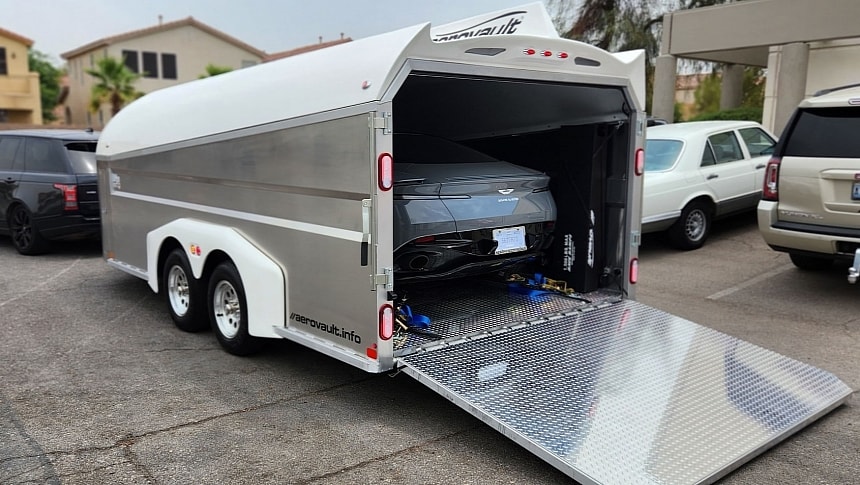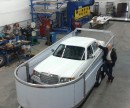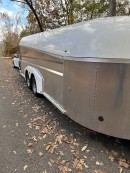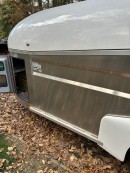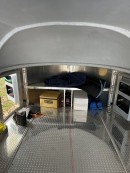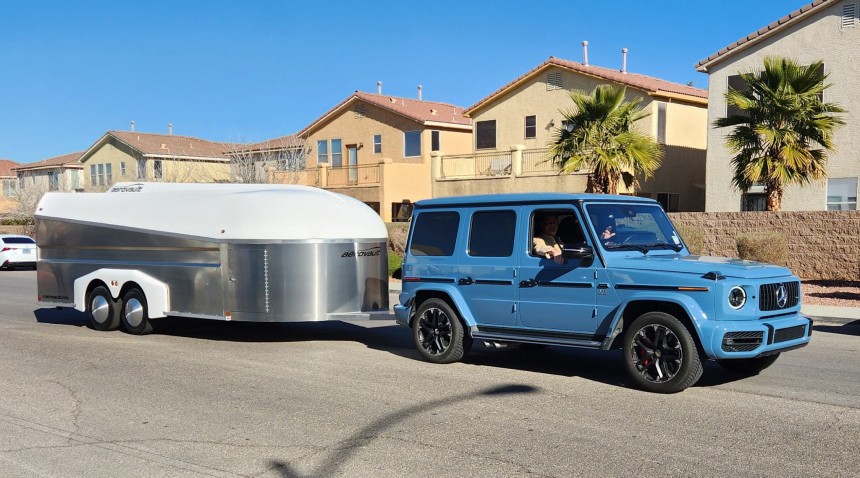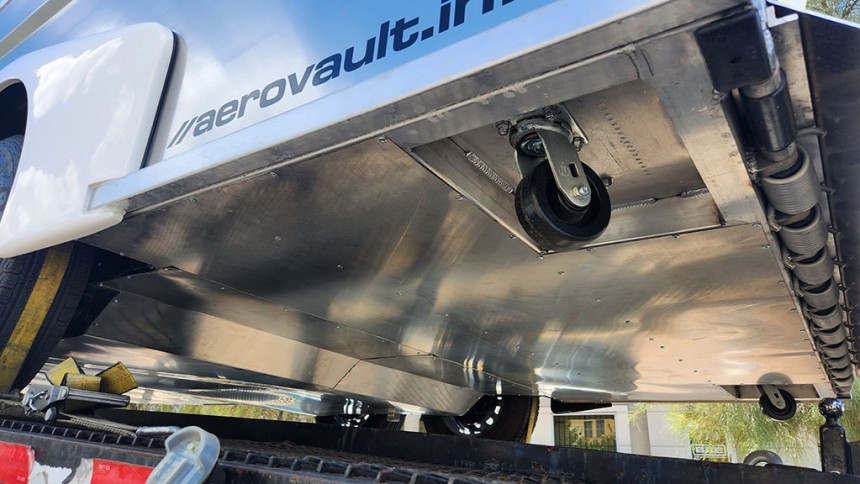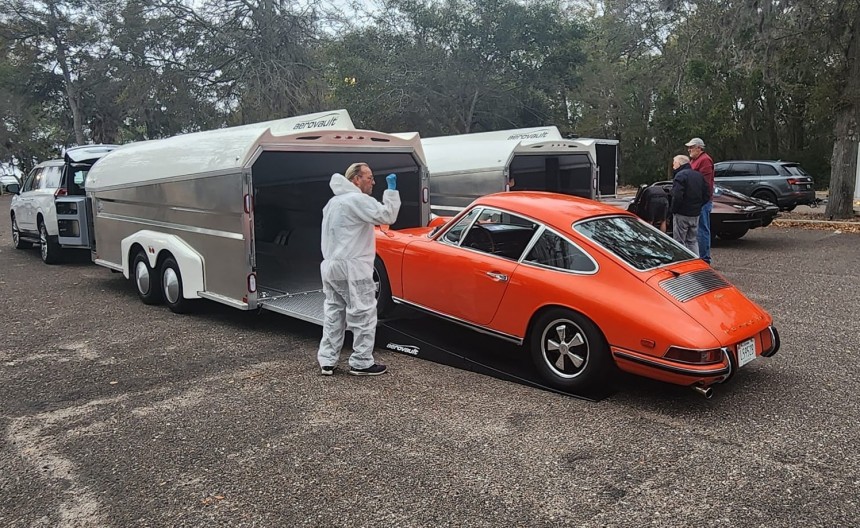"Why doesn't anyone in the trailer industry understand aerodynamics?!" These are the words that would mark the beginning of what can be considered the most streamlined car hauler on roadways. Oh, and none other than Peter Brock is responsible for it.
Folk's, today's story is all about something called the Aerovault, that slightly fashionable box on wheels you see in the gallery. Are you still having trouble figuring out what this thing is? It's a car hauler designed to be the most aerodynamic thing on the road, and as its name would suggest, it's designed to keep your most prized vehicle clean and scratch-free while transporting it around.
This story begins in 2008 when Brock encountered a problem with the vehicle trailer industry: no one knew how to build an aerodynamic and efficient unit. Thus, it was back to the drawing board, a place where Brock had plenty of experience. From there, well, the rest, as they say, is history.
So, just how is it that a trailer of this sort can be considered the most aerodynamic around? It looks kind of bulky, doesn't it? Well, looks are clearly deceiving because, as the manufacturer's website states, there's a "myth" about the whole V-shape trailer nose. As a result, we're actually looking at a trailer with more of a teardrop nose, just turned on its side.
Because of this, air is able to easily wrap around the front of the trailer without smashing into any straight edges that may influence how the trailer behaves, be it on straightaways or even during turns. From here, flat-surface panels complete the trailer, and on top of it all, a fiberglass cap sits in place to take care of any remaining airflow. Yup, it's a teardrop, alright. A few fins to help this bugger stay true to its path are also in place. I can't help but feel like I'm looking at an upside-down boat or an unfinished Formula 1 car. Looks change nothing; this one's all about functionality.
Now, what makes the Aerovault so dang good isn't just that flush aluminum body or molded fiberglass roof. The third piece of the puzzle is the trailer underside, a section often forgotten by countless manufacturers and a crucial aspect of the Aerovault's abilities.
It's here that Brock enclosed the underbelly of this smooth beast with panel after panel designed to carry any airflow toward the rear of the trailer and lay it to rest away from the unit. The axles get the very same treatment, providing an underside that's as smooth as a baby's bottom.
It's also worth mentioning that these babies are set up on a dual-axle design capable of handling up to a total weight of 7,500 lbs (3,402 kg). Since the largest model starts off with a weight of 2,540 lbs (1,152 kg), you have nearly 5,000 lbs (2,268 kg) to play around with.
With a decent idea of how this aluminum trailer's exterior is brought to life and what it's meant to achieve, it's time to scope out a bit about the interior. For this, we head to the rear of the Aerovault, where we find a large ramp door that lowers to let you easily slide your prized possession into place.
But, it's not just some empty box where your ride is to rest while in transit; rather, it includes a few features like a nose shelf and a few storage bins mounted into the little side doors integrated into the aluminum sides. Be sure to check out the video below to see precisely what I'm talking about. In case you need it, a spare tire is also thrown in.
Now, don't judge this trailer on the amount of headroom it can offer your average human. That's not what this is about. With that in mind, don't expect to be hanging around inside all day, but only to get your beauty in and out. As an idea, an image in the gallery shows a six-foot-tall Peter Brock hunching down a little bit.
As for the loading process itself, you could simply drive your car inside, but that would be so yesterday; just kidding. Instead, a winch with synthetic rope is used to slowly tug your precious into place. All that is to be controlled from a remote, so you won't get stuck trying to open any doors.
The question is, just how much can we expect to pay for one of these babies? Well, I really did my best to find the pricing for a new unit on the manufacturer's website, but I couldn't; with the help of Uncle Google, prices for this baby popped up as selling around the $40 to $50K range for a 2023 model, sometimes more, and dependent of the features inside. Other model years can be found selling for less, and sources from back in 2021 state that these babies we're selling start at around $26K. This is something to consider, especially in this day and age of EVs.
This story begins in 2008 when Brock encountered a problem with the vehicle trailer industry: no one knew how to build an aerodynamic and efficient unit. Thus, it was back to the drawing board, a place where Brock had plenty of experience. From there, well, the rest, as they say, is history.
Because of this, air is able to easily wrap around the front of the trailer without smashing into any straight edges that may influence how the trailer behaves, be it on straightaways or even during turns. From here, flat-surface panels complete the trailer, and on top of it all, a fiberglass cap sits in place to take care of any remaining airflow. Yup, it's a teardrop, alright. A few fins to help this bugger stay true to its path are also in place. I can't help but feel like I'm looking at an upside-down boat or an unfinished Formula 1 car. Looks change nothing; this one's all about functionality.
Now, what makes the Aerovault so dang good isn't just that flush aluminum body or molded fiberglass roof. The third piece of the puzzle is the trailer underside, a section often forgotten by countless manufacturers and a crucial aspect of the Aerovault's abilities.
It's also worth mentioning that these babies are set up on a dual-axle design capable of handling up to a total weight of 7,500 lbs (3,402 kg). Since the largest model starts off with a weight of 2,540 lbs (1,152 kg), you have nearly 5,000 lbs (2,268 kg) to play around with.
With a decent idea of how this aluminum trailer's exterior is brought to life and what it's meant to achieve, it's time to scope out a bit about the interior. For this, we head to the rear of the Aerovault, where we find a large ramp door that lowers to let you easily slide your prized possession into place.
But, it's not just some empty box where your ride is to rest while in transit; rather, it includes a few features like a nose shelf and a few storage bins mounted into the little side doors integrated into the aluminum sides. Be sure to check out the video below to see precisely what I'm talking about. In case you need it, a spare tire is also thrown in.
As for the loading process itself, you could simply drive your car inside, but that would be so yesterday; just kidding. Instead, a winch with synthetic rope is used to slowly tug your precious into place. All that is to be controlled from a remote, so you won't get stuck trying to open any doors.
The question is, just how much can we expect to pay for one of these babies? Well, I really did my best to find the pricing for a new unit on the manufacturer's website, but I couldn't; with the help of Uncle Google, prices for this baby popped up as selling around the $40 to $50K range for a 2023 model, sometimes more, and dependent of the features inside. Other model years can be found selling for less, and sources from back in 2021 state that these babies we're selling start at around $26K. This is something to consider, especially in this day and age of EVs.
